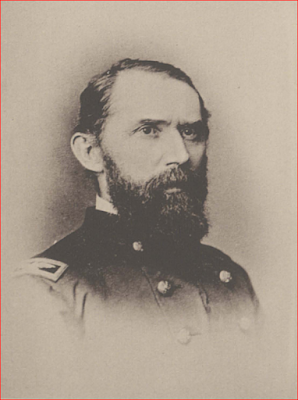William McKnight was a member of Company K, 7th Ohio Volunteer Cavalry Regiment, during the Civil War. McKnight was born in New Brunswick, Canada, on July 2nd , 1832. His father Thomas was from Scotland, so William was a Canadian, of Scottish heritage, fighting for the Union, in an Ohio regiment. McKnight was a resident of Rutland Township, Meigs County, Ohio, prior to the war. On March 8th, 1855 he married Samaria Braley of nearby Langsville, and the union would produce six children, Leila, Thomas, Susan, Mary, and twins Martha and Myrta, the latter who were born on July 4th, 1863. Prior to the Civil War McKnight earned a living as a blacksmith and would implore his wife to collect on debts owed by locals while he was awaiting for his pay while serving, as opposed to her obtaining from their families.
William joined the 7th OVC on September 12th, 1862 and was made sergeant on November 8th, 1862. The 7th was known as the "River Regiment" as most of the companies were filled by men from counties along the Ohio River. Organized at various locations around the state (Columbus, Ripley, Athens, Pomeroy, and Gallipolis), the regiment served three years and was involved in numerous engagements and battles during the war.
During the Great Raid of 1863, John H. Morgan was chased across Ohio by the 7th Ohio, but McKnight was not with the regiment during this time as he was at Nicholsville, Kentucky training new men for the regiment. On the raid Morgan's command passed through Langsville, where McKnight owned a house and Samaria and the six children, including the two week old twins, were living. The story goes that Samaria was in the act of fleeing as she had heard that Morgan's men would not treat civilians respectfully, but Morgan himself reassured her that no harm would come to Samaria or the children. While waiting for his command to complete crossing a nearby water obstacle, Morgan spent time conversing with Samaria. Regardless, when William found out that Morgan was literally on his front porch, he became infuriated with the thought that the horse thief Morgan had the audacity to speak to Samaria.
At Cynthiana, Kentucky, during Morgan's Last Kentucky Raid, Second Lieutenant William McKnight* would have his chance to seek "revenge" on Morgan. On the early morning of June 12th, 1864, the 7th Ohio Cavalry, part of Stephen Burbridge's Federal force that had been chasing after Morgan, encountered the Confederates on the east side of town. The resulting fight, which lasted about one hour, resulted in the complete rout of Morgan's men, but during the chase McKnight was mortally wounded on his left side. He languished for a few days before dying. In his pocket was found a poem he had written to Samaria in April, 1852. The paper was stained, perhaps from the blood of William's mortal wound.
At home in Langsville was a twenty-six year old Samaria, and her six now-fatherless children, aged nine and under, including the eleven month old twins who would not have a chance to know their father. Samaria never remarried, and was supported by her family, and later one daughter who lived with Samaria into her old age.
While certainly not the only soldier from Canada to fight during the Civil War, it is interesting to note that William supported the Union given his non-American background. And while the Second Battle of Cynthiana is but a small footnote in the annals of Civil War history, his death left as much home front impact as any fellow soldier killed at Chickamauga, or Shiloh, or Gettysburg.
* McKnight had been promoted on April, 19th, 1864.
* McKnight had been promoted on April, 19th, 1864.

















































